Salisbury: Designed to In-Spire!
by Moira Allen
Once you've
gotten past the traffic on the main roads, and navigated through
the winding back streets to find your hotel, and had a moment to
step out of your car and take a deep breath of Salisbury's crisp,
clean air, your first impression of this lovely cathedral town is
likely to be: Peace! Even the roads aren't as difficult to
negotiate as those in some towns: Since Salisbury and its streets
were carefully "planned" in the 13th century, rather
than evolving from a web of tracks, lanes and thoroughfares, they
aren't as likely to leave you frazzled (or lost).

Away from those main roads, however, the peace settles over you
like a balm. Traffic noises are far away. Even in the center of
town, life seems to move at a calmer, less fidgety pace, and if
you choose a hotel a bit further out (further out being "on
the other side of the Avon"), you'll find yourself gazing at
Salisbury Cathedral's famous 404-foot spire across green
water-meadows -- if you can tear your eyes away from the swans
gliding up and down the river at the bottom of the garden.
Speaking of gardens, that is likely to be your second impression
of Salisbury: flowers! Downtown, nearly every streetlamp is
decorated with a hanging basket of blooms, while on the
streetcorners you'll find flowerpots arranged in pyramids,
supported by iron frameworks. Every hotel seems to have its own
flower garden, as well as hanging baskets of flowers by the door
and anywhere else that will support a hook. As you walk through
the market square, whiffs of floral fragrance will greet you with
every shift of the breeze.
Salisbury, of course, is full of more than flowers; it is full of
history. The town we now know as Salisbury was once referred to
as "New Salisbury," to distinguish it from "Old
Salisbury" or "Old Sarum", the town that evolved
upon a hillfort just to the north of the "modern" town.
The new town of Salisbury was built on lands owned by the Bishop
of Salisbury. By the early 13th century, conflict between the
monks of Salisbury's original cathedral and the soldiers who
manned the fortress within which it stood had reached intolerable
levels (see the related article on Old Sarum), and the bishop
received approval to build a new cathedral elsewhere. The area
chosen was a stretch of marshy ground known as Myrifeld near the
River Avon, an area a later bishop described (not inaccurately!)
as "spacious fields of pleasantness". Work began on
the new cathedral in 1220, and the beginnings of "New
Salisbury" were laid out at the same time.
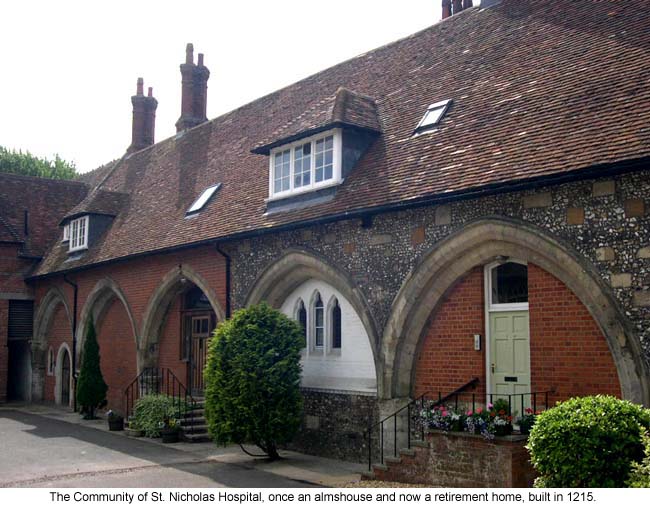
Because Salisbury was a "planned" town rather than one
that evolved from earlier villages or settlements, its streets
were laid out in rectangular patterns, and were unusually wide
for the day -- which is a boon to modern traffic! By the 14th
century, all the main streets had been established, with the
river as the town's western boundary and the line of the modern
Rampart Road as its eastern edge. Many streets retain their
medieval names, and many of these names, in turn, were taken from
the owners of nearby house owners. For example, Cheese Corner,
in the market place, was not where cheeses were sold, but rather,
was the location of the home of John Cheese, mayor of Salisbury
in 1290.
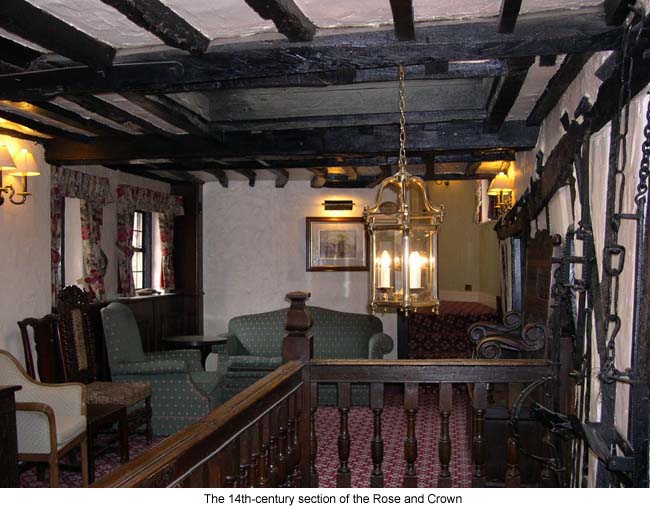
Many of Salisbury's medieval buildings have survived as well.
The Rose and Crown Inn, just across the Avon (and thus,
technically, "outside" the original town), dates from
the 14th century. Today, this very comfortable hotel offers
accommodations both in its modern addition and in the original
building; it also features an excellent restaurant, and a lovely
rose garden on the banks of the Avon. If you visit, be sure to
take a trip upstairs to see the 14th-century wattle-and-daub
corridor, criss-crossed with dark timbers; you'll be hard-pressed
to find a single straight line in the older section of the
building! You'll find more 14th-century timbers in the hotel's
original pub.
Another ancient (and luxurious) hotel is The Red Lion. Situated
just off the market square, this is believed to be England's
oldest "purpose-built" hotel -- i.e., a building that
began life as a hotel (rather than a manor or abbey or oast) and
remains one today. The building dates from 1230, and also boasts
an excellent (though pricey) restaurant. It's worth a visit just
to see some of the many antiques in the lobby, including a carved
fireplace mantel and a massive, carved wooded floor clock.
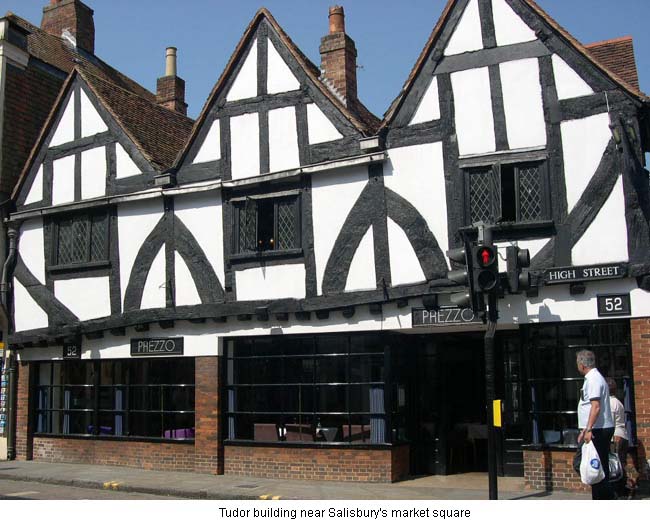
In the market square itself, you'll find Tudor buildings sitting
beside modern shops, and the stone-carved 13th-century market
cross (a shady spot where butter was once sold) just a short
distance from the Tesco supermarket. Salisbury's charter market
is still held in this square; don't even bother trying to find a
parking spot around here on the weekend!
Salisbury Cathedral
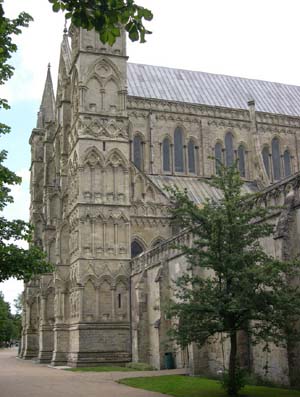 Wherever you wander in Salisbury, however, your
attention will always be drawn back to that spire, for the
cathedral is the heart of this town and the primary reason for a
visit. Officially the "cathedral church of the Blessed
Virgin Mary," its Foundation Stone was laid by Bishop Poore
in 1220, and the cathedral was dedicated 38 years later. Like
Salisbury itself, the cathedral design was planned, rather than
evolving from an earlier church -- or being added to in bits and
pieces over the centuries. Thus, it is all built in a single
style: Early English Gothic. The only significant additions are
the tower and spire, which was completed around 1330 and, at 404
feet (123 meters), is the tallest in Britain. (It is also the
tallest surviving spire in the world dating from before 1400.)
The top 50 feet of the spire were built from the outside, and
must be maintained from the outside; thus, iron rungs are set
into the stone so that an official (presumably with a good head
for heights) can regularly climb to the top of the spire and
inspect it! Wherever you wander in Salisbury, however, your
attention will always be drawn back to that spire, for the
cathedral is the heart of this town and the primary reason for a
visit. Officially the "cathedral church of the Blessed
Virgin Mary," its Foundation Stone was laid by Bishop Poore
in 1220, and the cathedral was dedicated 38 years later. Like
Salisbury itself, the cathedral design was planned, rather than
evolving from an earlier church -- or being added to in bits and
pieces over the centuries. Thus, it is all built in a single
style: Early English Gothic. The only significant additions are
the tower and spire, which was completed around 1330 and, at 404
feet (123 meters), is the tallest in Britain. (It is also the
tallest surviving spire in the world dating from before 1400.)
The top 50 feet of the spire were built from the outside, and
must be maintained from the outside; thus, iron rungs are set
into the stone so that an official (presumably with a good head
for heights) can regularly climb to the top of the spire and
inspect it!
Another benefit from this early planning was the decision to set
the cathedral in a large, open "close" (which may sound
like a contradiction in terms!). Thus, the building is not hemmed
in by later construction, and as you approach, you can see the
structure clearly from several angles. Come closer still, and
you'll see that the entire front face of the building is covered
with statues -- saints, bishops, kings and angels, their detailed
faces beautifully preserved. A carving of Mary holding the
infant Jesus, flanked by angels, presides over the main
doors.
Inside, one's impression is of space, openness, light. One of
the first sights to greet you is Europe's oldest working clock,
dating from 1386 or earlier. It's a bit large for the mantle,
with huge weights turning the iron cogs. The clock has no face;
it was designed to indicate the time by ringing a bell (which
summoned the bishops to service). It was originally located in a
bell tower that was torn down in 1792; the clock was restored to
working order in 1956. Ironically, today Salisbury cathedral has
no bells; the only other "bell-less" cathedrals in
England are Ely and Norwich.
 Besides the clock, there is much to see in the
cathedral: Magnificent stained glass windows or
"lights," pillars of Purbeck marble (which is actually
a crystalline limestone from Dorset), tombs and monuments of
every description, and beautifully carved and decorated wooden
quire stalls. Most of the windows date from the 1800's or later
(including some very modern windows); most of the older windows
were removed either during the Reformation (which was very hard
on stained glass!) or during James Wyatt's remodeling of the
cathedral in the 1790's. One memorial to look for in particular
is a revolving, illuminated etched Steuben glass prism depicting
the cathedral, donated by engraver Laurence Whistler to
commemorate his brother, Rex, who was killed in Normandy in 1944. Besides the clock, there is much to see in the
cathedral: Magnificent stained glass windows or
"lights," pillars of Purbeck marble (which is actually
a crystalline limestone from Dorset), tombs and monuments of
every description, and beautifully carved and decorated wooden
quire stalls. Most of the windows date from the 1800's or later
(including some very modern windows); most of the older windows
were removed either during the Reformation (which was very hard
on stained glass!) or during James Wyatt's remodeling of the
cathedral in the 1790's. One memorial to look for in particular
is a revolving, illuminated etched Steuben glass prism depicting
the cathedral, donated by engraver Laurence Whistler to
commemorate his brother, Rex, who was killed in Normandy in 1944.
The octagonal chapter house, which was built between 1263 and
1284, features an interior frieze depicting scenes from Genesis
and Exodus. In medieval times, the clergy started their day with
a reading of a chapter of the Bible in the Chapter House, and
this is also where cathedral business would have been discussed.
It is most noted today, however, for housing the one of the four
surviving original copies of the Magna Carta (and the best
preserved). Elias of Dereham, who supervised the construction of
the cathedral, was present at Runnymede when the Magna Carta was
signed, and was given the task of distributing the copies;
clearly he held on to one! (Another account attributes the
acquisition of the Magna Carta to William Longespee or Longpre,
the half-brother of King John and the first person officially
entombed in the cathedral. Allegedly, when Longespee's tomb was
opened centuries later, a dead rat was found in his skull, its
corpse containing traces of arsenic.) In addition to the Magna
Carta, many other ancient manuscripts are on display in the
Chapter House. (This is the one area of the cathedral where
photography is forbidden.)
If you find yourself a bit peckish after wandering through the
cathedral, the refectory offers an excellent selection of hot and
cold lunch dishes (and some very tempting desserts). Even more
tempting, however, is the fact that the cafeteria is in the same
room as the gift- and book-shop, so it's just about impossible to
avoid the temptation to leap up and shop as soon as you've
finished your pudding.
The Close
Once you've finished lunch at the cathedral, it's back to the
"close" to visit the rest of Salisbury's primary
historic attractions, which are conveniently clustered in this
central area. The close covers more than half a square mile, and
was deliberately laid out for openness. The original purpose of
the close was to provide housing for canons and dignitaries of
the cathedral within the cathedral precincts (which were later
surrounded by a wall in the 15th century). Inside the close,
you'll find the Salisbury and Wiltshire Museum (almost directly
across from the cathedral), the Wardrobe Military Museum, and the
Discover Salisbury Medieval Hall. Just outside the close, on the
Chorister's Green, is Mompesson House, and a short distance
beyond that is the Queen Elizabeth Gardens. A short walk north,
through the medieval gate to the High Street, will bring you to
the market place and a host of modern shops.
The Salisbury Museum is definitely the crown jewel of the close.
The building that houses it was first constructed in the late
11th century, and largely remodeled in the early 17th century.
In 1610 and 1612, Sir Thomas Saddler, registrar to the current
bishop of Salisbury, and his wife hosted King James I, Queen Ann
of Denmark, and Henry, Prince of Wales. From that point on, the
house was known as "The King's House." The house
retains its original wooden door, while a stained glass window on
the first floor shows the arms of Prince Henry. The house became
the site of the museum in 1980.
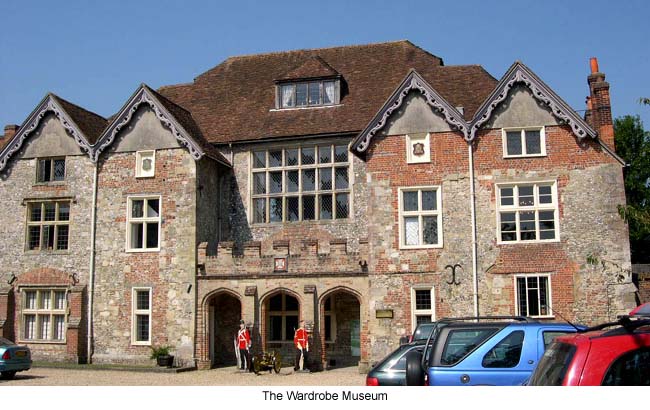
Here, you'll find galleries leading you through the entire
history of Wiltshire, from Neolithic days to the present. The
museum covers two large floors, with costumes and medical history
exhibits upstairs. One large gallery features the archaeological
discovers of William Pitt Rivers, who conducted a great deal of
research into the local megaliths but also conducted explorations
around the world. You'll also find temporary exhibits depicting
some aspect of country life or crafts; when we visited, the
museum was offering an exhibit on the construction of willow
"hurdles" and fences, and another on local pottery.
The bookstore is extremely tempting.
Conversely, you might want to give the "Discover
Salisbury" program at the "Medieval Hall" a miss,
unless you enjoy condescendingly touristy "orientation"
films. Ostensibly, the purpose of the program is to give the
visitor some background about Salisbury and Wiltshire. Trestle
tables are set up in a dimly lit hall, complete with flickering
fake torches. The first flick is narrated by "John and Mary
Salisbury," a middle-aged couple who are presumably meant to
be the long-lived avatars of the region, reminiscing jovially
(nudge nudge, wink wink) about the history they've seen over the
centuries. ("Yep, John, I remember them Neolithic farmer
fellers...") One can order tea and sandwiches to enhance
one's viewing pleasure. If you're tired, however, the dim, quiet
room is a great place for a nap (as one must listen to the films
through headphones, available in several languages).
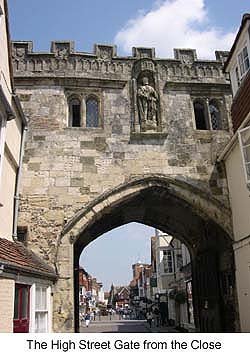 The
history of the building is far more interesting than its
orientation films. Actually, since 1277 it was the cathedral's
Deanery, assigned to the deans in perpetuity. In 1582, it was
also the site of an attempted murder. For unspecified reasons,
one John Farrant, organist and choirmaster, decided to murder
Dean John Bridges. He left the choir in the middle of a service,
headed across the close to the Deanery, found the dean at his
desk, and attempted to stab him. The dean managed to escape and
locked himself in an upstairs bedroom. Farrant returned to the
choir and finished the service. Several days later the Chapter
summoned him to give an account of his actions, but he failed to
appear and soon left the area. Shortly thereafter he applied for
a position as organist and choirmaster at Hereford Cathedral. The
history of the building is far more interesting than its
orientation films. Actually, since 1277 it was the cathedral's
Deanery, assigned to the deans in perpetuity. In 1582, it was
also the site of an attempted murder. For unspecified reasons,
one John Farrant, organist and choirmaster, decided to murder
Dean John Bridges. He left the choir in the middle of a service,
headed across the close to the Deanery, found the dean at his
desk, and attempted to stab him. The dean managed to escape and
locked himself in an upstairs bedroom. Farrant returned to the
choir and finished the service. Several days later the Chapter
summoned him to give an account of his actions, but he failed to
appear and soon left the area. Shortly thereafter he applied for
a position as organist and choirmaster at Hereford Cathedral.
Much more worthwhile is the Wardrobe Museum. Its full name is
the Royal Gloucestershire, Berkshire and Wiltshire Regiment
(Salisbury) Museum, but generally it is known as "Redcoats
in the Wardrobe." The building dates from 1254, and once
housed the bishops' robes and documents; hence, its title as
"The Wardrobe." It now houses an excellent collection
of militaria dating from the mid 18th-century through 1994,
including a number of beautiful silver pieces. Pass through the
museum and you can stroll through a lovely garden down to the
river. The museum also offers a small café (though not
quite as good as the one in the cathedral). The museum has an
excellent website, where you can actually view every item in the
collection (including some that are not on display).
One of the first buildings to be completed in the close after the
cathedral itself was the Bishop's Palace. It is a palace indeed;
in the 14th century, the bishops received a license to crenellate
(fortify) the building. In the 15th century, Bishop Beauchamp
added a tower and a new great hall. King James I and King Charles
I often stayed in the palace when visiting Salisbury. In 1689,
James II was staying at the palace while en route to Warminster,
where he intended to join his army and fight William of Orange.
However, while at the palace, he suffered a nosebleed that kept
him bedridden for three days, and during that time his generals
switched sides. William of Orange became king, and James was
forced to flee into exile.
During the Civil War, the palace was owned by the City of
Salisbury, which rented out various sections. A Dutchman turned
the ground floor into an alehouse, and so much damage was done to
the palace overall that the great hall had to be demolished; it
was restored late in 17th century. In 1947, the Bishop decided
that the palace was far too grand for a family residence and
moved to the South Canonry, and the palace is now used as the
Cathedral School. It is open to the public on certain days in
August.
Finally, just to the north of the close, on the north side of the
Chorister's Green, is Mompesson House. Thomas Mompesson leased a
building on this site from the cathedral in 1635, and the
existing house was built in 1701 in the Queen Anne style. It was
the Bishop's residence from the 1800's to 1951; it now belongs to
the National Trust. The house is decorated in Georgian style, and
includes fine plasterwork and period furniture, as well as a
collection of Turnbull drinking glasses. There is also a small
walled garden and a tea-room. In 1995, the house was used as a
location for the film Sense and Sensibility. The house is
open to visitors from April to October, from 12 to 5:30 p.m.
Saturday through Wednesday.
Beyond the Close
The Cathedral Close is a good place to start your tour of
Salisbury and its environs, but hardly the place to end it.
Salisbury is the ideal location from which to explore some of the
most interesting sites in Wiltshire, including Old Sarum (about
ten minutes from the town centre) and Stonehenge (less than half
an hour away). Other nearby attractions include Old Wardour
Castle, Wilton House, the Braemore House and Museum in
Fordingbridge (Hampshire), Stourhead House and Gardens
(Warminster), and the Rockville Roman Villa (also in Hampshire).
The great stone circle of Avebury is just over an hour's drive,
and Winchester (with yet another magnificent cathedral) is also
close by.
But don't spend all your time in Salisbury running to and from
from one sight to the next. Take some time to relax and soak in
the peace of its gardens and swans. It will surely inspire you
to want to return!

Related Articles:
- Timeline: Salisbury, by Darcy Lewis
- https://www.timetravel-britain.com/articles/towns/saltime.shtml
- Old Sarum: A Layer Cake of History, by Moira Allen
- https://www.timetravel-britain.com/articles/castles/sarum.shtml
- Wilton: Town of Mints, Carpets and Saints, by Moira Allen
- https://www.timetravel-britain.com/articles/towns/wilton.shtml
- Mompesson House, by Huw Francis
- https://www.timetravel-britain.com/articles/houses/mompesson.shtml
- The Eternal Mystery of Stonehenge, by Pearl Harris
- https://www.timetravel-britain.com/articles/stones/stonehenge.shtml
- Stonehenge: The Giants' Dance, by Sue Kendrick
- https://www.timetravel-britain.com/articles/stones/stonehenge1.shtml
More Information:
We regret that we no longer have the resources to maintain up-to-date links and/or hours and pricing details for the various sites and attractions listed on this website. For more information about the location(s) listed above, please use your favorite search engine or visit Wikipedia.
Moira Allen has been writing and editing professionally for more than 30 years. She is the author of seven books and several hundred articles. She has been a lifelong Anglophile, and recently achieved her dream of living in England, spending nearly a year and a half in the history town of Hastings. Allen also hosts the Victorian history site VictorianVoices.net, a topical archive of thousands of articles from British and American Victorian periodicals. Allen currently resides in Maryland.
Article and photos © 2007 Moira Allen
|
